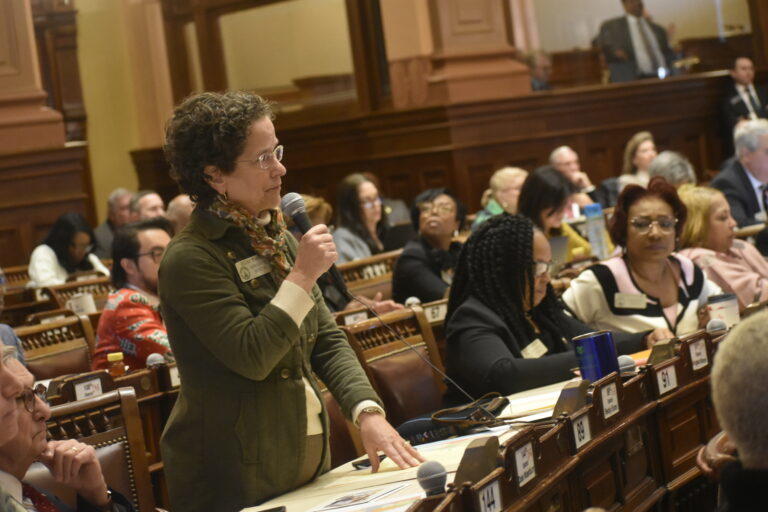
Caption
Democrats like state Rep. Becky Evans criticized the GOP congressional map for dismantling a majority minority district.
Credit: Ross Williams / Georgia Recorder
Depending on who is asked, a newly redrawn congressional map is either an open act of defiance or exactly what federal Judge Steve Jones instructed lawmakers to do when he struck down Georgia’s political maps for diluting the voting strength of Black voters.
That map, along with two revised legislative maps, will soon land on Jones’ desk for him to decide, although an appeal is expected either way. Gov. Brian Kemp signed off on all three maps Friday evening on the final day to submit the plans to the federal judge.
The three maps were quickly ushered through the legislative process during a just-ended special session. The high-stakes congressional map received a final vote Thursday after a bitter debate in the House over how GOP lawmakers went about creating the court-ordered new Black majority district in west metro Atlanta.
Republicans argue the congressional map complies with the judge’s order to create the new district. Democrats blasted their GOP colleagues for chopping up the racially and culturally diverse 7th District in the north Atlanta suburbs in the process. The 7th District is represented by U.S. Rep. Lucy McBath, who is a Black Democrat.
The district’s current form has a voting-age majority made up of a combined 66% Black, Latino and Asian people. The new map would make it about 66% white.
“So you put Blacks into the 6th District, but are you diluting the vote strength of Asian-American and Latino voters in Gwinnett County, which is also kind of an important thing?” said Emory University political science professor Andra Gillespie. “So are you, for all intents and purposes, fixing one problem, but then creating another problem?”
McBath represented the 6th District before the map was redrawn in 2021 to favor a Republican candidate, leading her to challenge a fellow Democrat in the 7th District. That change helped the GOP gain a congressional seat in Georgia last year, giving them a 9-5 majority that would likely remain if the new map survives judicial review.
Jones ordered lawmakers to redraw the maps in October after finding that Georgia’s district lines did not reflect the growth of the Black population. The state’s growth over the last decade was due to the minority population, yet no new majority Black congressional or legislative districts were created.
The judge ordered lawmakers to create the new majority Black congressional district and an additional seven majority Black legislative districts. In Georgia, Black voters tend to support Democrats at high rates, but the new maps are expected to yield minimal Democratic gains in the House and none in the Senate.
Democrats say the plans create additional majority Black districts at the expense of others where other non-white residents make up the bulk of the electorate, and they have accused Republicans of playing a “shell game” with the maps. The congressional map passed Thursday with a 98-72 vote that fell along party lines.

Democrats like state Rep. Becky Evans criticized the GOP congressional map for dismantling a majority minority district.
“Spoiler alert: Georgia has changed,” said Rep. Gregg Kennard, a Lawrenceville Democrat. “We grew a million people in the last decade, and the overwhelming majority of that growth was people of color and they brought their politics with them.
“Georgia is a purple state, a swing state, and fair maps should reflect that 50-50 political landscape,” he said. “How can you with a straight face draw a 9-5 congressional map?”
Rep. Sam Park, another Lawrenceville Democrat, argued Republicans cannot say they are complying with the order when they are dismantling a majority minority congressional district.
“This open defiance of a federal court order is alarming. It is reminiscent of the refusal to accept the outcome of the 2020 presidential election that led to the Jan. 6 insurrection,” Park said.
Republican lawmakers have frequently referenced the judge’s outline for a remedy, which calls for creating new Black majority districts. But Democrats have been just as quick to highlight another sentence in the order: “The State cannot remedy the Section 2 violations described herein by eliminating minority opportunity districts elsewhere in the plans.”
Others have pointedly accused Republicans of following the path of Alabama lawmakers, who unsuccessfully tried to rebuff a court order to create a new majority Black congressional district or “something quite close to it.”
“I oppose this map because this ain’t a Georgia map, this is an Alabama map,” said House Minority Leader James Beverly, a Macon Democrat.
Rep. Rob Leverett, an Elberton Republican who chairs the House redistricting committee, called the comparisons to Alabama a “low blow.”
“That is the bitterest pill right there, to be accused of being like our friends to the west,” Leverett said. “My goal this whole session has been to do just not what they did, to do everything opposite from what they did. And I don’t think you can say that we are being like Alabama when we are passing a map that includes an additional majority Black congressional district.”
Leverett countered that the redistricting case in Georgia centered on Black Georgians and no other minority groups, and the judge’s order specifically directed lawmakers to create additional majority Black districts.

State Rep. Rob Leverett, an Elberton Republican who chairs the House redistricting committee, said comparing Georgia’s redistricting efforts to Alabama’s was “a low blow.”
“We’re adding the additional majority Black districts in every plan just like the judge is telling us,” Leverett said.
The judge will soon have the opportunity to clear up any questions about his language.
Charles Bullock, a political science professor at the University of Georgia, said that Jones used very clear and precise language throughout his 516-page court ruling, distinguishing Black majority districts from minority opportunity districts.
“I think if he meant Black majority district he would have said Black majority district,” Bullock said. “I think he consciously chose the wording.”
Republicans also argue that while the Voting Rights Act protects a single minority group, it does not protect a coalition of ethnic groups such as those in McBath’s district.
Bullock said plaintiffs in other redistricting disputes have long argued that combining more than one racial group into a voting bloc also warrants protections for minority voters under the Voting Rights Act. He said that the plaintiffs in the Georgia case will have to prove that the individual racial groups in McBath’s district share enough interests to form cohesive political preferences.
A court hearing has been scheduled for Dec. 20 to review the new maps.
Republican Attorney General Chris Carr requested in a court filing this week that Jones appoint a special master by Jan. 16 to redraw the maps if Jones finds the new ones are not in compliance.
Carr wrote that the governor and General Assembly quickly held the special redistricting session after Jones’ ruling. He also stressed the importance of having district maps approved for a 2024 election cycle that begins with a presidential primary on March 12 and continues with a general election primary on May 21.
Bullock said there is a good chance that the maps that were just drawn will be used in 2024 while the case continues to be litigated. Any new maps must be ready with enough time for candidates and state and local election officials to prepare for an election and to also notify voters about the reshaped districts, he said.
“People say that business business leaders don’t like uncertainty, well neither do political leaders,” Bullock said. “You’re hired and fired by the people in your district so you want to know exactly who those people are and be responsive to them as well as trying to raise money from them.”
Two common forms of gerrymandering — redrawing districts to favor a certain outcome — are cracking, which occurs when the population is divided into multiple districts so they can’t make up a majority and get their candidates elected, and packing, in which people likely to support a candidate or party are shoveled into one area to limit their influence elsewhere. Either maneuver is illegal if done on the basis of race, and Jones will be keeping an eye out.
“The choices that Republicans made, breaking up the 7th District, putting the Black voters back into the 6th District, and then shifting the 13th District east, and then adding Black voters to the 5th District, are some very curious choices,” Gillespie said. “And they’re done in such a subtle way that it’s a question of whether or not they did this in a way that would pass muster, either for Judge Jones or for the appellate panel that will undoubtedly get to hear this particular case.”
“So it looks like Republicans were just rolling the dice that even if Jones invalidates the districts, that the map might survive on appeal,” she added.

The special session dragged lawmakers back to the state Capitol during the holidays. Pictured here is Woodstock Republican Rep. Charlice Byrd.
Similar battle lines have been drawn in the state Senate, where Republicans added new majority Black districts around Atlanta and Macon, but Senate Democrats say they did it without increasing the power of the Black vote as Jones wanted.
In south metro Atlanta, the districts of Democratic Sens. Elena Parent and Jason Esteves saw their Black populations increase to narrow majorities, less than in past cases that were designated as racial gerrymandering, which could be a quandary for Jones.
“You were looking at districts that were 70% Black, give or take a few percentage points,” Gillespie said. “And so the districts that are majority Black now that they’re creating are 51%, 52% Black. So it doesn’t really look like packing in the same way, but it is packing. Like if you think about Jason Esteves and Elena Parent’s districts, these districts were 22% and 29% Black beforehand. So if you are, in Esteves’ case, going to more than double the number of Black people in the district, does that constitute packing, even though it just gives African-Americans just a bare outright majority in the district?”
Gillespie said she’ll be watching Henry County, where Democratic Sen. Gail Davenport’s district is set to become about 60% Black.
“Does 60% constitute packing in this environment, especially when you’re trying to keep the adjacent district Republican?” she said. “You only make that 30% Black in an area where there’s clearly a fast-growing Black population. That 60% might actually be the one to trigger something, just because it is 60%, right? But Parent and Esteves’ districts being only 50% Black, that might not meet the standard for packing.”
If Jones is not happy, he could appoint a special master for any or all of the maps that aren’t up to snuff. That could be a problem for incumbents. The special master’s only duty will be to make a map that complies with the law, and that could mean drawing experienced legislators into districts with opposite politics or combining them in the same district with colleagues.
Gillespie said she’s among the political scientists who support nonpartisan redistricting, a process in practice in several states in which experts not affiliated with the legislature draw maps.
“I think we have to ask the fundamental fairness question of should we allow legislators to draw their own district lines, to basically choose their own constituents. And there’s something about that level of gamesmanship that I would argue is problematic.”
“From that perspective, having a special master draw the districts is as close as we’re probably going to get anytime soon to having nonpartisan redistricting.”
This story comes to GPB through a reporting partnership with Georgia Recorder.